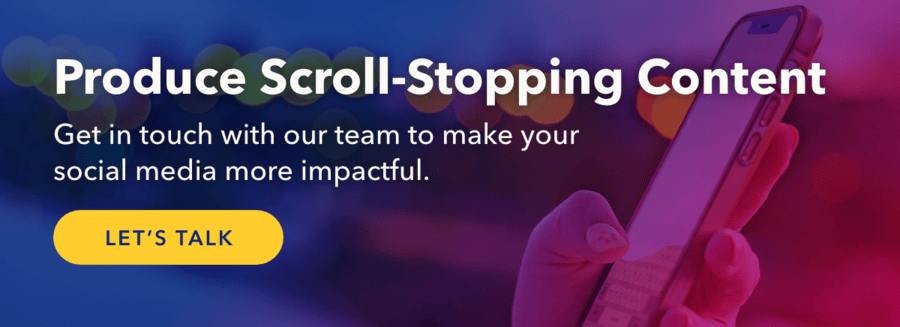A strong social media presence helps your brand connect with customers, build trust, and stay relevant. The challenge is posting consistently and creating the right mix of content that engages your audience.
In crowded feeds, the brands that stand out publish routinely, teach generously, and package insights in formats that are easy to consume. LinkedIn often does the heaviest lifting for B2B, so your strategy should prioritize it, then scale into other channels as needed.
That’s where planning is key. Instead of scrambling for daily ideas, a content calendar maps campaigns in advance, reduces guesswork, and keeps the team focused on execution. With the right framework guiding your efforts, you can build a social media plan that captures attention and supports growth without overwhelming your marketing resources.
One of the most effective strategies is the 70/20/10 approach – a simple way to make sure your content mix stays balanced, intentional, and audience-focused.
Understanding the 70/20/10 Approach
This model provides guardrails for your posting strategy across your active channels, starting with LinkedIn and expanding to Facebook, Instagram, X, and/or YouTube as appropriate. Aim for roughly 70% educational or brand-building content, 20% curated or shared insights, and 10% promotional posts. This structure helps you maintain relevance and ensure your feed never feels one-dimensional.
For cadence, many B2B teams see sold results posting on LinkedIn a few times per week rather than daily; quality and relevance beat volume here. The key is to make sure you’re providing value and showing authenticity. Test different formats, posting times, and frequencies to find the rhythm that resonates best and delivers the most engagement for your business.
Most (70%) of Your Content Should Educate and Build Trust
This is the bulk of your social storytelling – the posts that help buyers learn, solve problems, or feel more connected to your brand. Examples include original thought leadership and blogs that drive back to your site, quick “how-to” clips and explainer videos, employee spotlights that humanize your brand, and case study snapshots that reinforce credibility.
Video deserves special attention. On LinkedIn, video posts earn about 5x more engagement, and live video gets up to 24x more, making it a powerful way to stop the scroll with motion, faces, and quick demos.
Curated Content (20%) Adds Perspective
Sharing outside content doesn’t dilute your voice, it amplifies it. By curating insights from trusted sources, you show that your brand is in tune with industry conversations and invested in being a resource. Pull in relevant industry news, respected voices your audience already follows, partner or client highlights, and authentic user-generated content.
Recent data from Metricool shows that LinkedIn posts containing external links generate 13% more interactions and nearly 5% more views compared to posts without links, which overturns the long-held belief that linking reduces reach. Use links when they add value and be strategic.
Promotional Content (10%) Should Be the Smallest Slice of Your Mix
When used sparingly and strategically, promos draw attention to what’s new without overwhelming your feed. Announce launches and features, spotlight upcoming events or webinars, and share deeper resources like case studies and guides to move prospects through the buying journey.
Paid ads can take this content even further, extending reach and ensuring that the right people see it at the right time. But keep the organic feed focused on value so the occasional promo lands well.
How to Truly ‘Break Through’
Pairing the 70/20/10 approach with these best practices can add up:
- Lead with a clear takeaway in the first two lines.
- Show people and process, not just the product.
- Turn webinars and long-form assets into snackable posts.
- Use strong cover slides on carousels.
- Keep most videos short and captions.
- Invite conversation with a specific question rather than a generic call-to-action (CTA).
These moves make it easier for busy buyers to engage, especially on LinkedIn during work hours.
Scaling Social Success
A platform like HubSpot’s Marketing Hub helps you plan, publish, and measure everything in one place so you can work more efficiently and effectively. With its social media management tools, you can:
- Schedule posts across channels in advance to maintain consistency and save time.
- Monitor engagement by tracking likes, comments, shares, clicks, and follower growth in real time.
- Compare performance of different campaigns and platforms to optimize your investment.
- Link social activity with CRM contacts, making it easy to attribute traffic and conversions using UTMs and campaign tracking.
- Focus on meaningful metrics, like engagement rates and link clicks – not just vanity figures.
Stand Out and Stay Visible
Social media works best for B2B organizations when it’s balanced, consistent, and aligned to real buyer needs. Use 70/20/10 as your guardrail, lean into LinkedIn with a steady weekly cadence, and package your expertise in formats that invite engagement, especially video.
With a clear plan and the right tools, you’ll simplify execution, expand your reach, connect authentically, and stay top-of-mind.


